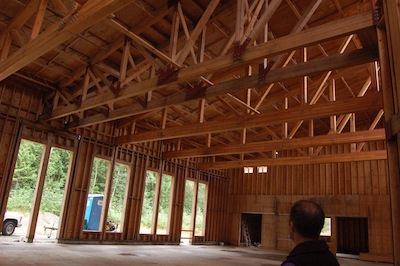By Joel Magalnick , Editor, JTNews

The front of the new Congregation Beth Israel from the front of the 17-acre property.
The construction of a new synagogue in Bellingham has been a decades-long process. But much has changed, in particular over the past year — including an actual structure.
“In a year we went from a hole in the ground to this magnificent shed,” said Rabbi Joshua Samuels of the northwest Washington city’s Congregation Beth Israel, of the two-story wooden shell at the back of an otherwise empty seven acre-lot.
The full size of the Reform congregation’s parcel is 17 acres, and the rest of the forested land will remain that way for the time being, with the possible exception of a road deeded to the city to connect the two neighborhoods the synagogue’s land straddles.
The genesis of the project goes as far back as 1990, when Beth Israel’s leadership launched a campaign to replace its 1925 synagogue near downtown Bellingham. They purchased the land in 2003, and have patiently raised money since to move forward in building phases.
Aside from Beth Israel, the only other Jewish organizations in Bellingham are Chabad and Hillel at Western Washington University. Given the community’s small size — Beth Israel’s membership currently stands at about 220 families — finding an angel to fund a $7 million project has been challenging at best. Without a large pool of money, the project must be completed in fits and starts.
“When we have enough money to clear the land, we clear the land. When we have enough money to build the foundation, we build the foundation,” said Dave Goldman, the chair of the capital campaign. “A lot of it is being patient. Fiscally responsible and patient.”
“We’ve done this while running a synagogue in the black, and not gone and done it with a loan,” said Jeff Jaffe, a second-generation Beth Israel member and past-president, who has been one of the prime forces behind getting the new synagogue constructed.
The next big push is to raise enough to begin protecting the existing structure from the elements, including installation of windows and roofing materials. Goldman said he hopes to have that money raised soon — recent rains have left shallow puddles on the subfloor in what will be the sanctuary.
The front of the building is currently being covered with concrete ground from a large rock that used to sit where the building now stands, molded to look like Jerusalem stone.
A look inside shows the bones of what will be a light and spacious structure when it’s finished. Just past the grand front entrance is a room that has Samuels excited: The library. Though most of its members probably don’t know it, the synagogue has an extensive collection of books, but due to lack of space in the current building they have remained in boxes at Jaffe’s home.
Samuels envisions classes, study sessions, nearly anything related to Jewish learning. It can “really serve much more of a purpose than a library,” he said.
The majority of the main floor will compose the sanctuary and social hall, where exposed wood beams already line the ceiling and tall windows look out onto forest land.
“Right now it’s like a Jewish barn,” said Rabbi Samuels.

The front of the building, where workers are putting up the homemade “Jerusalem” stone.
A patio behind the sanctuary will allow for outdoor social gatherings. A 6,000-square-foot second floor was added late in the game “for the cost of the floor,” according to Goldman, that can be used as recreation space or classrooms.
The main floor will also include a large kitchen and the rabbi’s study. Underneath, a second, smaller kitchen will be placed alongside eight classrooms, which will fit the 100 registered kids in the religious school — more than twice as Beth Israel had signed up before the arrival of Samuels and a new education director.

Rabbi Joshua Samuels and capital campaign chair Dave Goldman look onto the lot from the second floor.
There’s a reason Beth Israel purchased such a large parcel of land: It wants to be the center of “the infrastructure of Judaism in the city,” according to Goldman. That means the buildup of a Jewish community center, a day camp, even a Jewish senior center — but any such growth would be years down the road. But it also addresses a reality that faces synagogues in general and fundraising to complete this project in particular: People don’t want to donate to a project to build a lovely building. They want to donate to something relevant to their lives.
“My spiel to people is we’re not building a new Beth Israel synagogue,” Jaffe said. “What we’re doing is a Jewish center in the North Sound of Washington.”
In the middle of August, Samuels and the synagogue’s lay leaders were grappling with the bad news they had just received: Their near-term aspiration, to hold High Holiday services in the partially finished building, had been denied by county inspectors, due to potential liability issues.
Samuels had been hoping to get as many people as possible to the site just to see what has been built so they could see where their donations have gone — and possible finish the project.
“We felt that having Rosh Hashanah here would have been the most extraordinary moment in our community’s history,” he said.
None of Beth Israel’s leaders can say for certain when the building will be finished. But they say they are willing to do whatever they need to for their congregation to take ownership.
“I’ll sit on the floor until the office is done,” said Samuels. “I don’t mind being uncomfortable as long as our community can gather here.”
